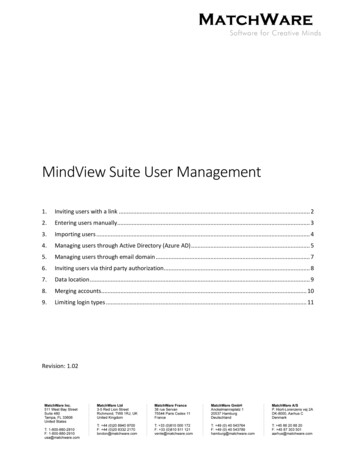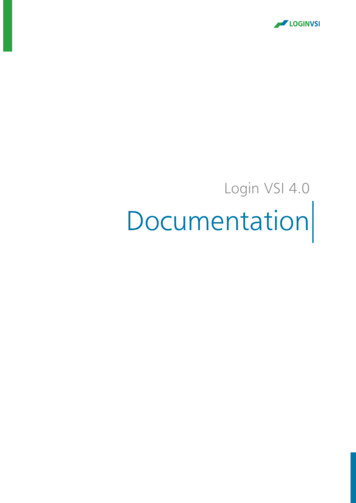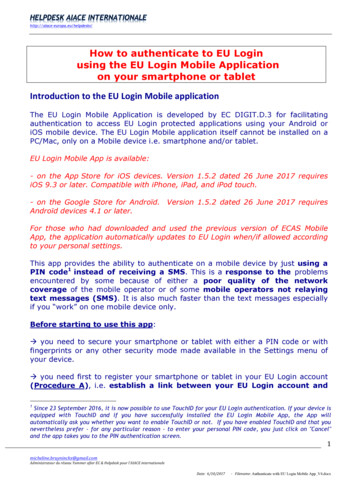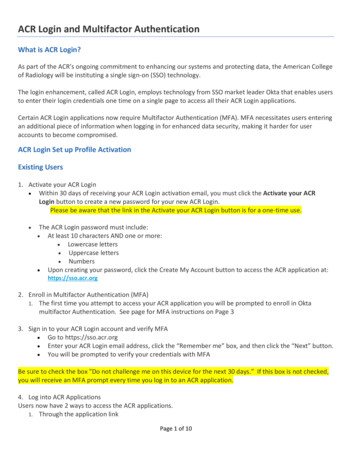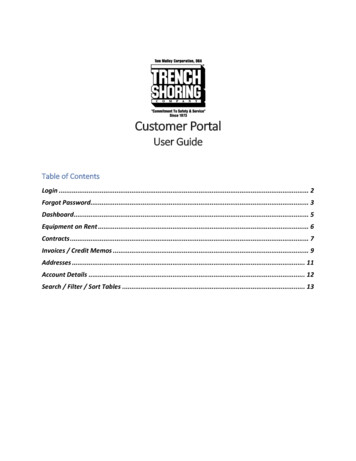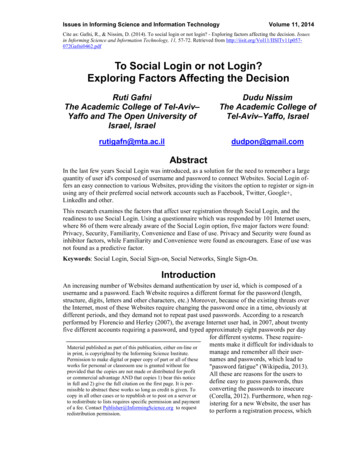
Transcription
Issues in Informing Science and Information TechnologyVolume 11, 2014Cite as: Gafni, R., & Nissim, D. (2014). To social login or not login? - Exploring factors affecting the decision. Issuesin Informing Science and Information Technology, 11, 57-72. Retrieved from fTo Social Login or not Login?Exploring Factors Affecting the DecisionRuti GafniThe Academic College of Tel-Aviv–Yaffo and The Open University ofIsrael, IsraelDudu NissimThe Academic College ofTel-Aviv–Yaffo, Israelrutigafn@mta.ac.ildudpon@gmail.comAbstractIn the last few years Social Login was introduced, as a solution for the need to remember a largequantity of user id's composed of username and password to connect Websites. Social Login offers an easy connection to various Websites, providing the visitors the option to register or sign-inusing any of their preferred social network accounts such as Facebook, Twitter, Google ,LinkedIn and other.This research examines the factors that affect user registration through Social Login, and thereadiness to use Social Login. Using a questionnaire which was responded by 101 Internet users,where 86 of them were already aware of the Social Login option, five major factors were found:Privacy, Security, Familiarity, Convenience and Ease of use. Privacy and Security were found asinhibitor factors, while Familiarity and Convenience were found as encouragers. Ease of use wasnot found as a predictive factor.Keywords: Social Login, Social Sign-on, Social Networks, Single Sign-On.IntroductionAn increasing number of Websites demand authentication by user id, which is composed of ausername and a password. Each Website requires a different format for the password (length,structure, digits, letters and other characters, etc.) Moreover, because of the existing threats overthe Internet, most of these Websites require changing the password once in a time, obviously atdifferent periods, and they demand not to repeat past used passwords. According to a researchperformed by Florencio and Herley (2007), the average Internet user had, in 2007, about twentyfive different accounts requiring a password, and typed approximately eight passwords per dayfor different systems. These requirements make it difficult for individuals toMaterial published as part of this publication, either on-line ormanage and remember all their userin print, is copyrighted by the Informing Science Institute.Permission to make digital or paper copy of part or all of thesenames and passwords, which lead toworks for personal or classroom use is granted without fee"password fatigue" (Wikipedia, 2013).provided that the copies are not made or distributed for profitAll these are reasons for the users toor commercial advantage AND that copies 1) bear this noticedefine easy to guess passwords, thusin full and 2) give the full citation on the first page. It is perconverting the passwords to insecuremissible to abstract these works so long as credit is given. Tocopy in all other cases or to republish or to post on a server or(Corella, 2012). Furthermore, when regto redistribute to lists requires specific permission and paymentistering for a new Website, the user hasof a fee. Contact Publisher@InformingScience.org to requestto perform a registration process, whichredistribution permission.
To Social Login or not Login?creates user friction. The user must spend time and effort filling in the required details, whichcause a large number of users drop-out in Web registration process (Goings & Abel, 2013; Malheiros & Preibusch, 2013), or give incorrect data (Goings & Abel, 2013).In enterprises, where multiple systems are used, the same problem emerged, and users needed tomanage a quantity of passwords. This problem was resolved using the Single Sign-On (SSO)platform which provides authentication and confirmation infrastructure of the user (Singh & Pais,2009). The SSO is a process where the users need to authenticate only once and they gain accessto multiple resources, reducing the number of logins and passwords in heterogeneous environments, which can be centrally managed in the enterprise. The same concept was further developed for individual users of the Internet, taking into account the fact that millions of Web usersare members of social networks, which need authentication for access. The idea is to use the logindata for the social network in order to connect to relying party Websites (Sun & Beznosov, 2012),so the passwords have to be remembered for fewer sites. This method is called "the Social Login"(SL), a term which was coined by the Janrain company (Goings & Abel, 2013). The relying partyis granted limited access to the user's account at the social network and can thus identify the userand obtain identity-related data; it can also issue updates on behalf of the user, which is an important benefit for some relying parties. The registration requirement means that the relying partycan only use as identity providers those social networks that it knows of and has gone to the trouble of registering with (Corella, 2012).Over the past few years, a continuous growing number of Websites implanted the option to connect via one or more social networks and encourage the users the register through Facebook,Twitter, Google or other social networks. Till 2011, more than two million Websites have embraced the Social Login platform of Facebook, and 15% of the top 10,000 most popular sitesadopted it (Kontaxis, Polychronakis, & Markatos, 2012). Figure 1 is an example of a login screen,in which the user can decide if using a regular account, with a specific username and passwordfor this Website, or a Social Login through one of the social networks.Figure 1: Example of Login screen with Social LoginThis paper explores the attitude of the individual users of the Internet, who are familiar with theSocial Login option, toward the use of such authentication method. The factors which encourageor inhibit the users to activate the social login apparatus are examined.The paper includes theoretical background explaining the different login methods, the researchquestions and used methodology, the findings, discussion and conclusions.58
Gafni & NissimTheoretical BackgroundLogin MethodsThere are several kinds of centralized login methods, in order to diminish the need to manage alarge number of usernames and passwords.1. Password managers are applications which help Web users to organize their online usernames and passwords (Mulligan & Elbirt, 2005). Password managers can reduce a user'smemory burden, as they need to remember only one master username and password; howeverthis does not prevent the need for usernames and passwords for each different Website, andthe need to change the passwords periodically.2. Single Sign-On (SSO). In a single sign-on platform, the user performs a single initial sign-onto an identity provider that contains the user information, which confirms the existence of theuser in the system. Each time the user wants to access an application, the mechanism automatically verifies that the user is properly authenticated by the identity provider, without requiring any direct user interaction. Single sign-on solutions eliminate the need for users to repeatedly prove their identities to different applications and hold different credentials for eachapplication (David, Nascimento, & Tonicelli, 2011). SSO helps to improve user's and developer's productivity by avoiding the user to remember numerous passwords and also reducethe amount of time the user spends on typing various login passwords. SSO also simplifiesthe administration, by managing single credentials instead of multiple credentials. It makeseasy to manage the rights of a user arriving, changing function in or leaving the company, toquickly integrate added applications, delegate access rights during holidays without increasing the helpdesk's workload. (Radha & Hitha Reddy, 2012).3. Web-based Single Sign-On (WSSO) is an Internet use oriented expansion of the SSO platform. This mechanism is meant to address the root causes of the site-centric Web. A WSSOsystem separates the role of the identity provider from that of the relying party. An identityprovider collects user identity information and authenticates users, while the relying party relies on the authenticated identity to make user authorization decisions. The main goal ofWSSO is to allow users to connect from one account to a number of Websites. Using WSSO,the users have fewer passwords to remember, are less demanding to enter their authenticationinformation and the Website content providers are free from the need to implant, maintainand secure accounts on the Website itself (Waters, 2012).Social networks, such as Facebook (Facebook, 2013) and Twitter (Twitter, 2012), developed thepossibility to allow users to register and login to different third party Websites using a single account, based on their social networking identification. These third party sites request users to authorize specific Web applications or APIs, to access and control part of their social profile. Thistype of interaction enables third-party sites to authenticate users based on their Facebook, Twitter,Google or other social networks' identities. In addition, such sites may add a social dimension tothe browsing experience by encouraging users to “like,” share, or comment on certain contentusing their social network capacity.There are several models of logins implemented in social networks; the most common are OAuthand OpenID.4. OAuth – a protocol published in 2010, is an authentication protocol that allows the user toaccess third party applications, such as Websites and processes that run on browsers, mobileor oriented devices without sharing the user identity or information. In order to use OAuth asWSSO, the social network keeps the user identity information and authenticates them, while59
To Social Login or not Login?the third party Website works as a relying party that relies on the user authenticated identityto authorize the user and to personally customize the user experience (Leiba, 2012).5. The OAuth 2.0 authorization protocol, published in October 2012, is an evolution of OAuthwhich standardizes the delegated authorization on the Web. Facebook's Social Login platform, known as Facebook Connect (Facebook, 2013) is based on the OAuth 2.0 protocol thatallows third party sites to authenticate users by gaining access to their Facebook identity.Other popular social networks such as Google and Twitter use this protocol as well in orderto enhance the user experience of social sign-on and social sharing. The intermediary authorization code can be potentially leaked during the transmission, which then may lead to itsabuse (Yang & Manoharan, 2013). Researches argue that OAuth 2.0 is too simple to be completely secured; it is designed without cryptographic protection, such as encryption and digital signature. The lack of encryption in the protocol requires the relied parties to employ somekind of security method, but many Websites do not follow this practice (Sun & Beznosov,2012).6. OpenID is a different protocol that allows a user-centric authorization (Bellamy-McIntyre,Luterroth & Weber, 2011). The user selects the preferred identity provider from a variety ofservices that had been offered through OpenID. The singularity of OpenID is that the identityprovider does not require any prior relationship with the Website or Web service for which itis providing the authentication. OpenID is a decentralized authentication protocol.The Adoption of the Social LoginWeb-based single sign-on schemes are being deployed by more and more commercial Websitesto safeguard many Web resources (Thierer, 2011).The Social Login mechanism allows various features and benefits, both for the user and the Websites' owners, but also has some barriers for adoption.Benefits:1. Single user-id for many services – The Social Login removes the users need to identify theiridentity in every application used. Therefore, the user doesn't need to remember differentusernames and password combinations (Chadwick, Inman, Siu, & Ferdous, 2011).2. The user establishes one connection to a reliable identity provider via a social network. Subsequently, each time the user would like to access an application he will be recognized as authenticated by the identity provider without the user intervention (Chadwick et al., 2011).3. The use of a single user id for many services releases time and cognitive effort from users,and therefore avoiding "password fatigue" (Wikipedia, 2013). Thus, they can define a uniquebut complicated password, which will transform the applications use better protected and safe(Wang, Chen, & Wang, 2012).4. A well-built Social Login lowers significantly the need for frequent maintenance of an authentication infrastructure for site owners. Gradually, Social Login reduces the site ownercosts and increases the security level of the site (Wang, Chen, & Wang, 2012).Barriers:1. Privacy – There is concern that identity providers may collect personal and sensitive information about the user by connecting many relying parties. Social Login usage statistics (Kontaxis et al., 2012) show that more than 250 million people might not fully realize the privacyimplications. Certain Websites do not offer even the minimum of their functionality unlessusers meet their demands for information and social interaction. At the same time, in a large60
Gafni & Nissimnumber of cases, it is unclear why these sites require all that personal information for theirpurposes.2. Loss of anonymity – Simple operation such as connecting to a third party using an identityprovider endangers the user's anonymous surfing, due to the fact that the social network userid usually contains personal information about the identity, and among others his real name(Kontaxis et al., 2012).3. Security threats – Wang, Chen, and Wang, (2012) discovered eight serious logic flaws inhigh-profile id providers and relying party Websites, such as OpenID (including Google IDand Pay Pal Access), Facebook, Jan Rain, Freelancer, Farm Ville, Sears.com, etc. Every flawallows an attacker to sign in as the victim user. They reported their findings to the affectedcompanies, who fixed them. Their study shows that the overall security quality of SSO deployments seems to be worrisome. One major problem in using these Social networks forSSO is that they perform little or no authentication of their users’ identities at registrationtime, another major problem is that some of these sites have very weak password policies, soit is relatively easy to masquerade as the site’s user (Chadwick et al., 2011).Sun, Pospisil, Muslukhov, Dindar, Hawkey, and Beznosov (2011) conducted a research to examine the users' adoption of the OpenId protocol. They found that the participants had several behaviors, concerns, and misconceptions that hinder the OpenID adoption process: (1) their existingpassword management strategies reduce the perceived usefulness of SSO; (2) they expressed concerns with single-point-of-failure related issues; (3) they were concerned about the possibility thatcredentials will be given to the content providers; (4) many were hesitant to consent to the releaseof their personal information; and (5) many expressed concern with the use of OpenID on Websites that contain valuable personal information or, conversely, are not trust-worthy. Sun et al.(2011, 2013) conducted two lab-experiments (first an exploratory one with 9 participants (2011)and then a second one with 35 participants and a post-session questionnaire (2013)), in order todefine the problems and consequently define a better user interface to diminish the users mental'smodel gap regarding WSSO. They identified some intrinsic variables that could be improved bythe design of a WSSO system and some extrinsic variables that are difficult to resolve with technology. The intrinsic variables they found include perceived (1) ease of use and (2) risk perception. The extrinsic variables they found were (1) use of existing password managers on the computer; (2) experience; (3) value of personal information, and (4) a single point of failure concern.The risk perception can be disassembled into Security and Privacy concerns. The use of existingpassword managers on the computer can be also called Convenience, because people do not wantto remember many different passwords. The experience variable can be also called Familiaritywith the mechanism. The concern of exposing valuable personal information is a risk concern ofPrivacy and the single point of failure concern is a Security issue.Figure 2 shows a sample of the Social Login connection to a relied Website using the LinkedInconnection. As can be seen, the Website requires permission to access the user's full profile andemail address, without explaining the consequences of such permission.61
To Social Login or not Login?Figure 2: Example of access to a relied Website screen using LinkedIn Social LoginResearch QuestionsThe aim of the research is to find the factors which encourage or inhibits the individual Internetusers to employ the Social Login apparatus. Users’ perspectives on WSSO have not been thoroughly investigated (Sun, Pospisil, Muslukhov, Dindar, Hawkey & Beznosov, 2013). Accordingto the benefits and barriers for the adoption of WSSO and Social Logins found in the literaturereview, Familiarity, Convenience, Ease of use, Security and Privacy concerns where the factorsexamined in this research.Familiarity – When people are familiar with a method, they tend to use it. Familiarity gives riseto trust (Gefen, 2000), which is essential to adopt a new technology. The Social Login is a newmechanism, which is still not enough known to Internet users (Chadwick et al., 2011). This factorfits the experience variable in Sun et al. research (2013).Convenience – Remembering usernames and passwords, changing them once in a time, is a difficulty for most of the Internet users, especially because individual's attention is limited (Davenport& Beck, 2001). This factor fits the fact that people use existing computer based password managers with weak and reused passwords, because it is difficult to remember many different passwords (Sun et al., 2013).Ease of Use – The use of a computerized mechanism which is not trivial to ordinary users mayslow down its adoption. Any system that is adopted for Social Login must be very easy to useotherwise users will soon get frustrated and lose interest (Sun et al., 2013, Chadwick et al., 2011)Privacy – Signing on to a relying party using the social network identity, which, in most of thecases, contains the real name, sacrifices the anonymity of the user, and therefore its privacy (Kontaxis et al., 2012). Using this information, the site can get access to the user's personal data, andreveal demographic information, get access to their friends through the social network, etc. Usersare concerned about losing their privacy (Sun et al., 2013).Security – Security threats in surfing the Internet are increasing. When a large number of applications and Websites receive credentials to access user profiles, this data may be subject to loss,62
Gafni & Nissimtheft or accidental leakage (Kontaxis et al., 2012), and even to web-based attacks (Bansal, Bhargavan, & Maffeis, 2012). The security of a SSO solution critically depends on several assumptions such as trust relationship amongst the involved parties and security mechanisms like thesecure transport protocols used to exchange messages. Many security recommendations that areavailable are useful in avoiding the most common security pitfalls but are of little help (Kaur &Bansal, 2013). Users do not understand all security issues regarding passwords and authentication(being comfortable with weak or reused passwords, for example), and have some misconceptionsabout security, but they are generally concerned about security issues (Sun et al., 2013).RQ1 – At what extent the various factors introduced encourage or inhibit the use of SocialLogin?H1 – Familiarity, convenience and ease of use will encourage users to sign in with the SocialLogin mechanism, while security and privacy will inhibit its use.RQ2 – Are the individuals who participate in many social networks more receptive to use SocialLogin apparatus? Do the introduced factors influence differently on those individuals?Membership in a social network is, obviously, the essential requirement in order to use SocialLogin. There are individuals who join more than one social network. These individuals are introduced to the Social Login apparatus through all the social networks they joined.H2 – Individual who participates in more different social networks will be more affected by thebeneficing factors and less affected by the inhibiting factors. Furthermore, they will be more recumbent in using the Social Login apparatusRQ3 – Are those individuals who actually use the Social Login apparatus influenced by the introduced factors differently than those individuals that do not use the Social Login mechanism?H3 – Individuals who actually use the Social Login will be more impacted by the beneficing factors and less by the inhibiting factors. Moreover, they will desire that the Social Login mechanism will be spread over the Internet and useful in more Websites.MethodologyThis research is based on data collected using a questionnaire that measured the attitude towardlogin to Websites using Social Login services. The survey included questions measuring the participants’ agreement with statements regarding their attitudes on a scale of 1 to 5 (very little extent, little extent, medium extent, high extent, very high extent).Due to the requirement to be familiar with the Social Login apparatus, a snowball sample selection (Baltar & Brunet, 2012; Corbitt, Thanasankit, & Yi, 2003; Noy, 2008) was used, and eligibleparticipants were recruited via the social network Facebook. The Web survey, elaborated usingGoogle Drive, enabled keeping the anonymity of the participants.There were 101 responses to the online survey, where 15 respondents did not know the SocialLogin option, thus they didn't fill the attitudes' questions, and so they were omitted, leaving 86records available.The responses of 16 of the attitudes' questions were analyzed with factor analysis dimension reduction, using Varimax rotation, in order to find the factors affecting the Social Login adoption.Reliability analysis, measured by Cronbach’s alpha was performed for those questions belongingto the same factors. The factors that were computed are:Ease of use (E), Familiarity (F) and Convenience (C) – The higher the mean, the higher the respondents think Social Login is useful.63
To Social Login or not Login?Security (S) and Privacy (P) – The higher the mean, the higher the respondents are afraid of security and privacy issues.Correlations among the factors were conducted, in order to find the relation between them.Further, correlations were computed, between the factors and the responses to three other questions:(1) The actual usage of Social Login by the respondent.(2) The number of social networks the user is subscribed to.(3) The extent the user thinks that Social Login shall be implemented in all Websites demandinglogin.The purpose of these correlations was to find the effect of each factor to the willingness to use theSocial Login mechanism.ResultsThe data were analyzed using IBM SPSS Statistics, version 20.Table 1 summarizes the descriptive statistics of the 101 total participants in the survey and the 86who were familiar with Social Login.Table 1: Descriptive statistics of the survey participantsnGenderAverage ageComputer familiarity:lowaveragehighInternet use:0-2 hours per day3-5 hours per day 5 hours per dayUse of sites which needauthentication:none1 per day2-5 per day 5 per dayUse of Social Login:neververy remotelysometimesmostlyalwaysTotal10153 male (52.5%)48 female (47.5%)26.56 (SD 5.89)range 20-59Social Login8649 male (57%);37 female (43.0%)26.56 (SD 2.43)range 20-4812 (11.9%)43 (42.6%)46 (45.5%)6 (7.0%)37 (43.0%)43 (50.0%)6 (5.9%)44 (43.6%)51 (50.5%)4 (4.7%)37 (43.0%)45 (52.3%)1 (1%)6 (5.9%)49 (48.5%)45 (44.6%)04 (4.7%)40 (46.5%)42 (48.8%)24 (23.9%)17 (16.8%)32 (31.7%)21 (20.8%)7 (6.9%)9 (10.5%)17 (19.8%)32 (37.2%)21 (24.4%)7 (8.1%)Table 2 specifies the items constructing each factor, their mean and standard deviation, the constructs’ discriminant validity and. the reliability, with values ranging from .714 to .885. Consider-64
Gafni & Nissiming the small sample size (n 86), the values suggest that the construct measurement is reliable.Principal component factor analysis with Varimax rotation was used to examine construct's discriminant validity. As shown in table 2, the items loaded high (.486-.917) on their designatedconstructs, and low (.000-.357), on the other constructs. Thus, there is a satisfactory level of construct discriminant validity. (The appendix contains the items specifications).Table 2: Reliability of the survey’s itemsRotated Component Matrix aFamiliarEase ofConvenityuseienceItemMeann .0.781.905.234.298.625.650.3410.817.613Extraction Method: Principal Component Analysis.Rotation Method: Varimax with Kaiser Normalization.Table 3 presents the mean and standard deviation of the five factors, as well as the Spearman’srho correlation coefficient between them.65
To Social Login or not Login?Table 3: Spearman’s rho correlationsFactorPrivacyFamiliarityEase ofUseConvenienceSecurityMean(SD)n 86CorrelationcoefficientSig. (2tailed)CorrelationcoefficientSig. (2-tailed)CorrelationcoefficientSig. (2tailed)CorrelationcoefficientSig. (2-tailed)CorrelationcoefficientSig. 000)(.687)(.000)Ease of UseConvenienceSecurity********(.000)**1.000**. Correlation is significant at the 0.01 level (2-tailed).Table 4 presents the correlation between (1) the actual usage of Social Login of the respondent,(2) the number of social networks the user is subscribed to, (3) the extent the user thinks that Social Login shall be implemented in all Websites demanding login and the different factors.Table 4: Spearman’s rho correlations to other variablesPrivacyFamiliarityEase of UseConvenienceSecurityCorrelationcoefficientSig. (2-tailed)CorrelationcoefficientSig. (2-tailed)CorrelationcoefficientSig. (2-tailed)Correlation coefficientSig. (2-tailed)CorrelationcoefficientSig. (2-tailed)(1) actual .747)(.000)(.000)(2) num of subscribed socialnetworks(3) SL implementation in .000)(.000)(.542)(.000)(.000)****. Correlation is significant at the 0.01 level (2-tailed).*. Correlation is significant at the 0.05 level (2-tailed).Table 5 presents the correlation between the three questions.66
Gafni & NissimTable 5: Spearman’s rho correlations between 3 variables(1) actual SL usage(2) num of subscribedsocial networks(3) SL implementation inall WebsitesCorrelation coefficientSig. (2-tailed)Correlation coefficientSig. (2-tailed)Correlation coefficientSig. (2-tailed)1.000.253*.350**(.019)(.001)(2) num of sub1.000.253*scribed social(.019)networks**(3) SL imple.350**.367mentation in all(.001)(.001)Websites**. Correlation is significant at the 0.01 level (2-tailed).*. Correlation is significant at the 0.05 level (2-tailed).367**(1) actual SLusage(.001)1.000Table 6 compares the attitudes of the 60 participants who use Social Login, with those of the 26who do not use it. The cutting point defined as 3. (There were only 2 participants who marked 3;defining the cutting point as 4 revealed very similar results) .As can be seen in Table 6, therewere significant differences in the attitudes towards four factors: convenience, security, familiarity and privacy; and no difference in the attitudes towards ease of use.Table 6: Attitudes of users using SL or not towards the factors analyzedFactorsSL users SL non users(n 60)(n 26)mean (SD) mean (SD)n 86, df 84Convenience3.68 (1.138) 2.31 (1.175)5.096.000Security3.28 (.799)4.31 (.717)-5.621.000Ease of Use4.47 (.761)4.40 (.836).386.700Familiarity3.45 (1.028) 2.03 (1.009)5.880.000Privacy3.57 (.768)-4.565.0004.37 (.689)t-testsig.,2-tailedDiscussionThe Social Login mechanism is fairly new, and it is gaining popularity both between the usersand the Website owners. Most of the researches which have been done about SSO in general andabout Social Login in particular, try to improve the algorithms and user interfaces of the mechanism. The factors inhibiting and encouraging the users' adoption of the Social Login were lessstudied.The results of this research can be useful both to Websites owners and to social networks developers. The understanding of the Social Login apparatus, its characteristics and the public's attitude to those characteristics can help deciding to which kinds of Websites it can be appropriate,according to the target audience of the specific Website.67
To Social Login or not Login?The research was based on 101 respondents, who 85.1% were aware of Social Login, and 59.4%already using it. According to the report of Abel (2012), 87% of online consumers are aware ofSocial
The idea is to use the login data for the social network in order to connect to relying party Websites (Sun & Beznosov, 2012), so the passwords have to be remembered for fewer sites. This method is called "the Social Login" (SL), a term which was coined by the Janrain company (Goings & Abel, 2013). The relying party

